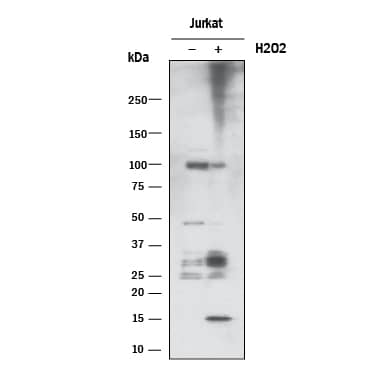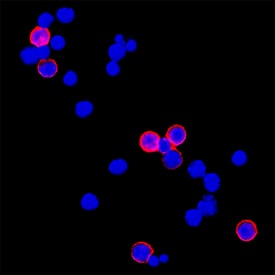Human/Mouse/Rat Slit3 Antibody Summary
Ser27-His901
Accession # Q9WVB4
Customers also Viewed
Applications
Please Note: Optimal dilutions should be determined by each laboratory for each application. General Protocols are available in the Technical Information section on our website.
Scientific Data
 View Larger
View Larger
Slit3 in 13 D.P.C. Mouse Embryo. Slit3 was detected in immersion fixed paraffin-embedded sections of 13 d.p.c. mouse embryo using Goat Anti-Human/Mouse/Rat Slit3 Antigen Affinity-purified Polyclonal Antibody (Catalog # AF3629) at 5 µg/mL for 1 hour at room temperature followed by incubation with the Anti-Goat IgG VisUCyte™ HRP Polymer Antibody (VC004). Before incubation with the primary antibody, tissue was subjected to heat-induced epitope retrieval using Antigen Retrieval Reagent-Basic (CTS013). Tissue was stained using DAB (brown) and counterstained with hematoxylin (blue). Specific staining was localized to developing braiin and cartillage.
Preparation and Storage
- 12 months from date of receipt, -20 to -70 °C as supplied.
- 1 month, 2 to 8 °C under sterile conditions after reconstitution.
- 6 months, -20 to -70 °C under sterile conditions after reconstitution.
Background: Slit3
Slit3 is a member of the slit family of large secreted axon guidance molecules that are ligands for Robo receptors (1). Like other mammalian family members, the 1523 amino acid (aa) Slit3 contains a signal sequence followed by 23 leucine-rich repeats (LRR) and nine EGF-like sequences (1). Mammalian Slits also contain a laminin-G domain between EGF6 and EGF7, and a C-terminal cysteine-rich domain (1). In Drosophila Slit, specific LRR are sites of ROBO interaction and homodimerization (2). Drosophila Slit shows equal similarities with all three mouse slit proteins, which are 59‑66% identical with each other (1). During development, Slit3 is expressed in the ventral neural tube, developing sensory organs, limb buds and developing areas of the limbs in patterns that overlap with but are discrete from Slit1 and Slit2 (1). Axons will not be allowed to recross the floor plate unless all three Slit genes are disrupted, suggesting some overlap in function (3). Slit3 is also expressed in the lung, kidney, skeletal muscle and heart, both during development and postnatally (1, 4‑6). ROBO2 is often found in complementary areas (4). Mice with genetically disrupted Slit3 have thin diaphragms with disorganized collagen fibrils and frequently develop diaphragmatic hernias (5, 6). Abnormalities in kidney development may also occur (5). Although Slit proteins are generally considered to be secreted, significant amounts of Slit3 may be retained in the mitochondria because of features in the signal sequence that indicate a high probability of mitochondrial targeting (7). Secreted Slit is often membrane-associated (7). Mouse Slit3 shows 98% and 94% amino acid identity with rat and human Slit3, respectively.
- Yuan, W. et al. (1999) Dev. Biol. 212:290.
- Howitt, J. A. et al. (2004) EMBO J. 23:4406.
- Long, H. et al. (2004) Neuron 42:213.
- Greenberg, J. M. et al. (2004) Dev. Dyn. 230:350.
- Liu, J. et al. (2003) Mech. Dev. 120:1059.
- Yuan, W. et al. (2003) Proc. Natl. Acad. Sci. USA 100:5217.
- Little, M. H. et al. (2001) Am. J. Physiol. Cell Physiol. 281:C486.
Product Datasheets
Citations for Human/Mouse/Rat Slit3 Antibody
R&D Systems personnel manually curate a database that contains references using R&D Systems products. The data collected includes not only links to publications in PubMed, but also provides information about sample types, species, and experimental conditions.
6
Citations: Showing 1 - 6
Filter your results:
Filter by:
-
Protein Ligands in the Secretome of CD36+ Fibroblasts Induce Growth Suppression in a Subset of Breast Cancer Cell Lines
Authors: Jabbari K, Winkelmaier G, Andersen C et al.
Cancers
-
Slit3 by PTH-Induced Osteoblast Secretion Repels Sensory Innervation in Spine Porous Endplates to Relieve Low Back Pain
Authors: Crane, J;Zhang, W;Otte, A;Barik, S;Wan, M;Cao, X;
Research square
Species: Transgenic Mouse
Sample Types: Tissue Homogenates, Whole Cells, Whole Tissue
Applications: Immunohistochemistry, Western Blot, Neutralization -
N-cadherin directs the collective Schwann cell migration required for nerve regeneration through Slit2/3-mediated contact inhibition of locomotion
Authors: Hoving, JJA;Harford-Wright, E;Wingfield-Digby, P;Cattin, AL;Campana, M;Power, A;Morgan, T;Torchiaro, E;Quereda, V;Lloyd, AC;
eLife
Species: Mouse
Sample Types: Cell Lysates
Applications: Western Blot -
Tissue-specific angiogenic and invasive properties of human neonatal thymus and bone MSCs: Role of SLIT3-ROBO1
Authors: Shuyun Wang, Shan Huang, Sean Johnson, Vadim Rosin, Jeffrey Lee, Eric Colomb et al.
Stem Cells Translational Medicine
-
Estrogen receptor (ER) agonists differentially regulate neuroangiogenesis in peritoneal endometriosis via the repellent factor SLIT3.
Authors: Greaves E, Collins F, Esnal-Zufiaurre A, Giakoumelou S, Horne A, Saunders P
Endocrinology, 2014-07-22;155(10):4015-26.
Species: Mouse
Sample Types: Whole Cells
Applications: Neutralization -
CD36+ Fibroblasts Secrete Protein Ligands That Growth-Suppress Triple-Negative Breast Cancer Cells While Elevating Adipogenic Markers for a Model of Cancer-Associated Fibroblast
Authors: K Jabbari, Q Cheng, G Winkelmaie, S Furuta, B Parvin
International Journal of Molecular Sciences, 2022-10-22;23(21):.
FAQs
No product specific FAQs exist for this product, however you may
View all Antibody FAQsImmunohistochemistry Reagents
Isotype Controls
Reconstitution Buffers
Secondary Antibodies
Reviews for Human/Mouse/Rat Slit3 Antibody
There are currently no reviews for this product. Be the first to review Human/Mouse/Rat Slit3 Antibody and earn rewards!
Have you used Human/Mouse/Rat Slit3 Antibody?
Submit a review and receive an Amazon gift card.
$25/€18/£15/$25CAN/¥75 Yuan/¥2500 Yen for a review with an image
$10/€7/£6/$10 CAD/¥70 Yuan/¥1110 Yen for a review without an image




















